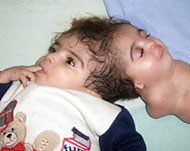Egyptian baby’s second head removed
Egyptian doctors have carried out a complicated operation to remove a second head from an 11-month-old girl suffering from one of the rarest birth defects.

Abla al-Alfi, a consultant in paediatric intensive care at the hospital in Binha near Cairo, said that baby Manar was in a serious but improving condition after the procedure to treat her for craniopagus parasiticus – a problem related to that of conjoined twins linked at the skull.
“We are still working on the baby. After surgery you get unstable blood pressure, you get fever. But she is stabilising,” al-Alfi said. “We have some improvement.”
As in the case of a girl who died after similar surgery in the Dominican Republic a year ago, the second twin had developed no body.
According to Dr Nasif Hanawi, the second twin had a complete face, a separate brain, a rib cage and underdeveloped bone structure.
The head that was removed from Manar had been capable of smiling and blinking but had no independent life, doctors said.
Video footage provided by the hospital, a national centre in Egypt for children’s medicine, showed Manar smiling and at ease in a cot with the dark-haired “parasitic” twin, attached at the upper left side of the girl’s skull.
Under observation
According to Dr Muhammad Lutfi Ibrahim, the leading brain surgeon involved in the operation, the medical team faced several obstacles throughout their 16 hours of surgery.
 |
|
The second twin (R) possessed |
He said one obstacle was how to remove a vital vein feeding the twin.
After the 16-hour operation, the baby had her head swathed in bandages and body wreathed by tubes, in an intensive care ward.
A separate twin sister, Nura, is healthy after initial problems with the birth on 30 March 2004.
Al-Alfi said the 13-strong surgical team separated Manar’s brain from the conjoined organ in small stages, cutting off the blood supply to the extra head while preventing increased blood flow to Manar’s heart, which would have risked cardiac arrest.
Binha, 40km north of Cairo, was chosen for its equipment and proximity to the girl’s family.
“The family of the child are from near here, we have the equipment, we assembled a team, so why not have the operation here?” said al-Alfi, explaining the choice not to work in Cairo or at centres abroad with more experience in separating conjoined twins.
Skull reconstructed
Al-Alfi said Manar’s skull had been reconstructed during surgery and her skin had been joined over the bone, leaving no need for further reconstructive surgery.
|
“We are still working on the baby. After surgery you get unstable blood pressure, you get fever. But she is stabilising” Abla al-Alfi, |
The doctors decided not to carry out Manar’s operation soon after her birth: “We studied the babies well,” Alfi said. “We had to study how the blood supply of the parasite is working.”
She plans to keep Manar in intensive care for up to 10 days and remains cautious: “Things are getting better, but at any time things can go wrong.”
The rare birth defect occurs when an embryo begins to split into identical twins but fails to complete the process and one of the conjoined twins fails to develop fully in the womb.
The second twin can form as an extra limb, a complete second body lacking vital organs, or, in very rare cases, a head.
Last February, seven-week-old Rebeca Martinez died in the Dominican Republic after surgery to remove a second head.
The leader of that team, Jorge Lazareff of the University of California at Los Angeles, noted on viewing one picture of the Egyptian baby that the face of the undeveloped twin was very well developed compared to that in Rebeca’s case.
Egyptian doctors have said craniopagus parasiticus is so rare it is found in only one in a million birth defects. Dr Hanawi says only 180 similar cases have been documented since the first century BCE.